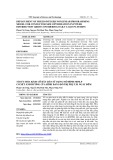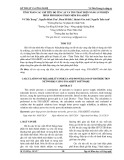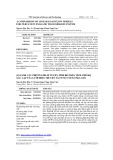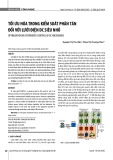
TNU Journal of Science and Technology
229(06): 21 - 31
http://jst.tnu.edu.vn 21 Email: jst@tnu.edu.vn
A NOVEL PARTICLE SWARM OPTIMIZATION GUIDED GENETIC
TO THE DISTRIBUTION NETWORK RECONFIGURATION PROBLEM
WITH AN OBJECTIVE FUNCTION OF MINIMUM OPERATING
AND POWER OUTAGE COSTS
Nguyen Tung Linh1*, Pham Vu Long2
1Electric Power University, 2Institute of Energy
ARTICLE INFO
ABSTRACT
Received:
16/11/2023
In operating the distribution network, the problem of reconfiguration
distribution network according to the change of load to reduce power
loss has partly reduced the operation cost of the distribution network but
it can impact the reliability of power supply to the load. Therefore, in
this study, we propose a hybrid algorithm that integrates two well
established methods, including the genetic algorithm (GA) and the
particle swarm optimization (PSO) algorithm for the problem of
reconfiguration distribution network with the objective function of the
with the objective function of reducing power loss considering operating
costs and power outage costs on the distribution network. To
demonstrate the performance of the proposed PSO-GA Algorithm
simulations have implemented through MATLAB 2019ª and
PSS/ADEPT software. Utilizing the IEEE 33-bus distribution system for
the experiment. The results show that the algorithm provides decision-
makers with a range of equivalent options when addressing the challenge
of distribution network reconfiguration.
Revised:
22/3/2024
Published:
22/3/2024
KEYWORDS
Genetic Algorithm
Particle Swarm Optimization
Distribution network
Reconfiguration distribution
network
Optimization
ĐỀ XUẤT ÁP DỤNG GIẢI THUẬT PSO – GA CHO BÀI TOÁN
TÁI CẤU HÌNH LƯỚI ĐIỆN PHÂN PHỐI CÓ XÉT ĐẾN TỐI ƯU HÓA
CHI PHÍ VẬN HÀNH VÀ CHI PHÍ NGƯNG CẤP ĐIỆN
Nguyễn Tùng Linh1*, Phạm Vũ Long2
1Trường Đại học Điện lực, 2Viện Năng lượng
THÔNG TIN BÀI BÁO
TÓM TẮT
Ngày nhận bài:
16/11/2023
Trong vận hành lưới điện phân phối, bài toán cấu hình lại mạng lưới
phân phối theo sự thay đổi của tải nhằm giảm tổn thất điện năng giúp
phần nào giảm chi phí vận hành của mạng lưới phân phối nhưng sẽ ảnh
hưởng đến độ tin cậy cung cấp điện của tải. Trong nghiên cứu này, chúng
tôi đề xuất một giải thuật kết hợp giữa hai thuật toán đã được chứng minh
hiệu quả, đó là kết hợp giải thuật di truyền (GA) và giải thuật tối ưu hóa
bầy đàn (PSO) cho bài toán tái cấu hình với hàm mục tiêu là giảm tổn
thất công suất có xét đến chi phí vận hành và chi phí ngừng cấp điện trên
lưới phân phối. Để chứng minh hiệu suất của giải thuật PSO-GA được đề
xuất, mô phỏng đã được thực hiện thông qua phần mềm MATLAB
2019a, và hệ thống lưới phân phối mẫu IEEE 33- nút được sử dụng trong
mô phỏng. Kết quả thực nghiệm cho thấy giải thuật được đề xuất cung
cấp các cấu trúc tối ưu khi giải quyết vấn đề tái cấu hình lại lưới điện
phân phối khi xét đến chi phí vận hành và ngưng cấp điện.
Ngày hoàn thiện:
22/3/2024
Ngày đăng:
22/3/2024
TỪ KHÓA
Thuật toán di truyền (GA)
Thuật toán bầy đàn (PSO)
Lưới phân phối
Tái cấu hình lưới điện phân phối
Tối ưu hóa
DOI: https://doi.org/10.34238/tnu-jst.9246
* Corresponding author. Email: linhnt@epu.edu.vn

TNU Journal of Science and Technology
229(06): 21 - 31
http://jst.tnu.edu.vn 22 Email: jst@tnu.edu.vn
1. Introduction
Distribution networks are commonly arranged in a radial structure due to the
straightforwardness in managing and modifying such systems. In normal operating conditions,
the performance of these networks can be optimized by adjusting the status of sectionalizing and
tie switches, while respecting system limitations and striving to achieve operational goals. This
optimization procedure is referred to as Distribution Network Reconfiguration (DNR) [1]. Over
the past thirty years, extensive research has explored various approaches to address the
challenges of DNR. Since this strategy relies on heuristic methods, systematically arriving at the
optimal solution poses a challenge. The concept of DNR was originally introduced by [2] as a
strategy to reduce losses in feeders Civanlar et al. [3], Baran et al. [4] presented two distinct
techniques that vary in their accuracy of simulating power flow in networks.
In contemporary research, meta-heuristic techniques have gained recognition for their
capacity to solve complex combinatorial optimization problems and secure globally optimal
solutions. Prominent among these methods are the Genetic Algorithm (GA) and Particle Swarm
Optimization (PSO). The inaugural proposal of a GA-centric approach for Distribution Network
Reconfiguration (DNR) was documented in [5], employing string representations to map the
states of switches. Nonetheless, the lengthy nature of these strings in extensive networks posed
challenges for the GA's search efficiency. Initial trials showed potential in minimizing losses, yet
they were marred by lengthy computation times. Subsequent adaptations of the GA for DNR
have been developed. Zhu [6] improved GA's performance by altering the representation of the
string to only reflect open switches, thereby reducing the string size and incorporating system
constraints into the fitness function along with an adaptive mutation strategy to regulate mutation
probability. Mendoza et al. [7] proposed a new minimal loss reconfiguration approach,
employing fundamental loops and modified genetic operators to manage the search space.
Enacheanu et al. [8] combined matroid theory and graph theory with GA for loss minimization in
distribution networks. The practice of adaptive GA was explored in [9], employing graph theory
to seed the initial population with feasible solutions. Braz and Souza [10], [11] and others have
leveraged GA for optimizing network configurations to reduce losses and switching operations.
Despite GA's proficiency with discrete variables and nonlinear objectives, its time efficiency
remains a concern, and not all problems are amenable to GA solutions. To address this and
enhance solution quality—especially to evade local optima—alternative meta-heuristics like PSO
have been introduced. PSO has shown notable success in optimization, directing a population of
particles by historical performance data. Its applications in DNR have been varied, from
enhancing load balancing to quality-performance trade-offs. Sivanagaraju et al. [12]
demonstrated a discrete PSO algorithm for DNR, noting its computational intensity due to non
radial solutions. Enhanced PSO variants have been developed to quicken the search by
incorporating historical solutions [16], and the Niche Binary PSO (NBPSO) aims to sidestep the
issue of premature convergence endemic to standard PSO [12].
In this study, the research team developed an objective function to minimize power losses that
considers the cost of opening/closing switches on the distribution network. The study suggests
the application of a hybrid approach combining Genetic Algorithm (GA) and Particle Swarm
Optimization (PSO) for solving the optimization problem. Here, the PSO algorithm is used to
direct the initial population generations for the GA, aiming to reduce computation time and
ensure the attainment of an optimal solution while avoiding the GA's tendency for local
optimization. The research findings have been validated on the IEEE 33-node test system,
indicating reliable results that can potentially be applied to real-world distribution networks.

TNU Journal of Science and Technology
229(06): 21 - 31
http://jst.tnu.edu.vn 23 Email: jst@tnu.edu.vn
2. Mathematical Model and Proposed Method
The reconfiguration distribution network involves strategically opening and closing
sectionalizing and tie switches. This process maintains a radial network topology and ensures
continuous power supply to all end-users. Adjusting the network's structure changes the
distribution of power across nodes, affects power loss, and impacts the system's overall
reliability. The main goals of this reconfiguration are to reduce overloads on lines and
transformers, minimize energy losses, and enhance the power supply's reliability. This ultimately
aims to decrease the costs associated with power outages.
2.1. Distribution network operating cost
The single-line schematic representation of a distribution line is in the present Figure 1.
10 i-1 ii+1 n
P0,Q0P1,Q01 Pi-1,Qi-1 Pn,Qn
PL1,QL1 PL1-1,QL1-1 PLi,QLi Pn,Qn
Pi,QiPi+1,Qi+1
PL1+1,QL1+1
Figure 1. Single-line diagram of a line
Sequentially, the active and reactive power values on branch (i+1) are deduced using the
given approximate power formulas.
[
| |]
(1)
[
| |] (2)
The active power loss on the line from node i to i+1 is ( ) [
| |] (3)
The load graph of daily and seasonal load patterns is shown in Figure 2, it shows that the
power consumption of the loads varies by hour, by load characteristics and by season.
Figure 2. The graph of daily load for the distribution network in a season
The operating cost function for the distribution network in one season of the year.
∑
∑
(4)
Where: active power loss at time ij; : active and reactive power on branch i. is
the connection node voltage of the branch on branch i.
The distribution network must adhere to the constraint that voltage and current levels remain
within their prescribed limits.
| | (5)

TNU Journal of Science and Technology
229(06): 21 - 31
http://jst.tnu.edu.vn 24 Email: jst@tnu.edu.vn
| | (6)
The pseudocode for calculation the operating costs of the distribution network a season is
presented in Figure 3.
Figure 3. The pseudocode Algorithm for calculating operating costs in a season/year
2.2. Power outage cost
Consider a simple single-source distribution network in Figure 4.
Figure 4. Diagram of a single-source two-load distribution network
Assuming that each network section has a section device, the power outage time of each load
is as follows: ;
or (7)
Where: λi, Tsci, and Tmđi-1 represent fault intensity, fault time at node i, and time of power
outage from source, or circuit breaker to node i – 1, respectively;
The power that cannot be supplied to customers at the moment is:
(8)
The power outage cost of the distribution network can be calculated through the damage
caused by the fault to customers with interrupted power supply:

TNU Journal of Science and Technology
229(06): 21 - 31
http://jst.tnu.edu.vn 25 Email: jst@tnu.edu.vn
∑
(9)
Where: is the number of loads in the power network. is the power unit price at the power
outage, also known as the unit price applicable to a violation of the power supply contract of load
i ($/kWh), which is often many times higher than the normal power selling price C0. is the
amount of power that cannot be supplied to customers. is the active power at node i (kW). Tsci
is the repair time of load i (h). λsci is the fault intensity of the load node on the line (times/year).
The steps of the algorithm to calculate the power outage cost are as follows the pseudocode
algorithm to calculate power outage cost for each configuration in Figure 5.
Figure 5. The pseudocode algorithm to calculate power outage cost for each configuration
2.3. Objective function of the math problem
A functional goal for reconfiguring the electrical network that incorporates considerations
of power delivery dependability can be formulated based on the aim to diminish both the
operational expenses and the cost implications of power interruptions for consumers, as
detailed below:
* + {[ ∑
] ∑
+ (10)
Where: the number of survey days in a year, the power consumed at node i (kW), is
the total power loss on the network at time j, is the survey time in a day, Tsci is the repair time
of load i (h), λsci is the fault intensity of load node on the line (times/year or times/season), is
normal power unit price of load i ($/kWh), is power unit price at the power outage of load i
($/kWh), are factors for selecting the objective function.












![Trắc nghiệm Mạch điện: Tổng hợp câu hỏi và bài tập [năm hiện tại]](https://cdn.tailieu.vn/images/document/thumbnail/2025/20251118/trungkiendt9/135x160/61371763448593.jpg)













